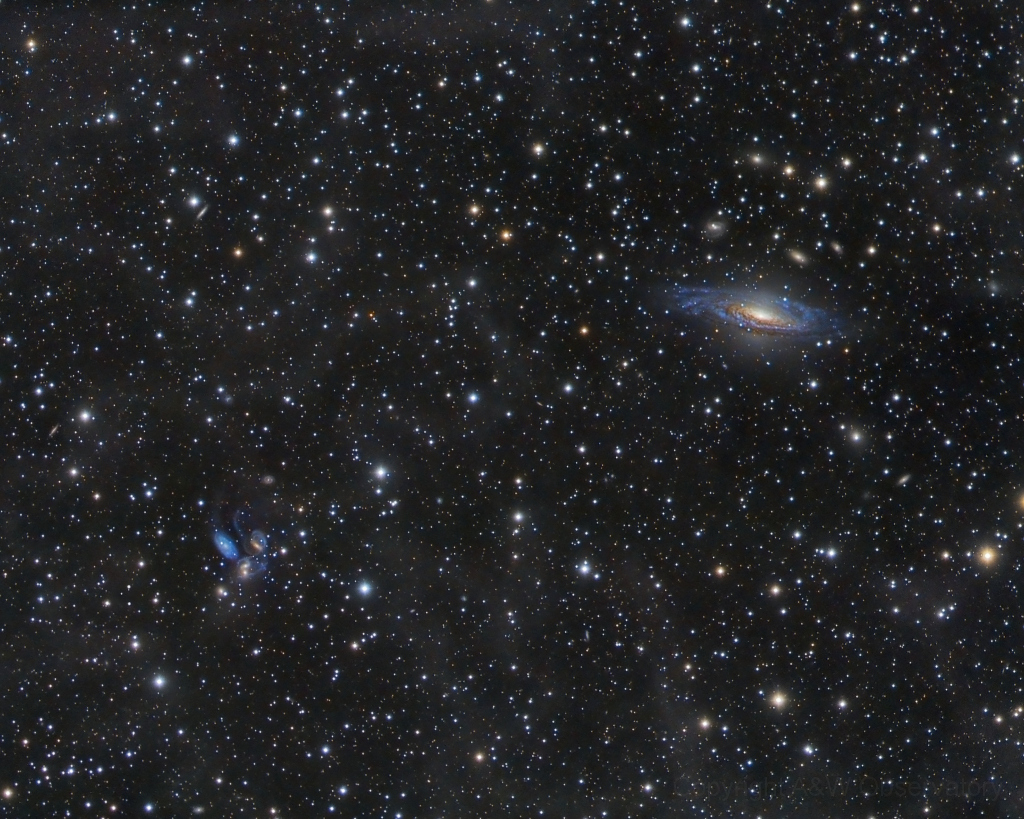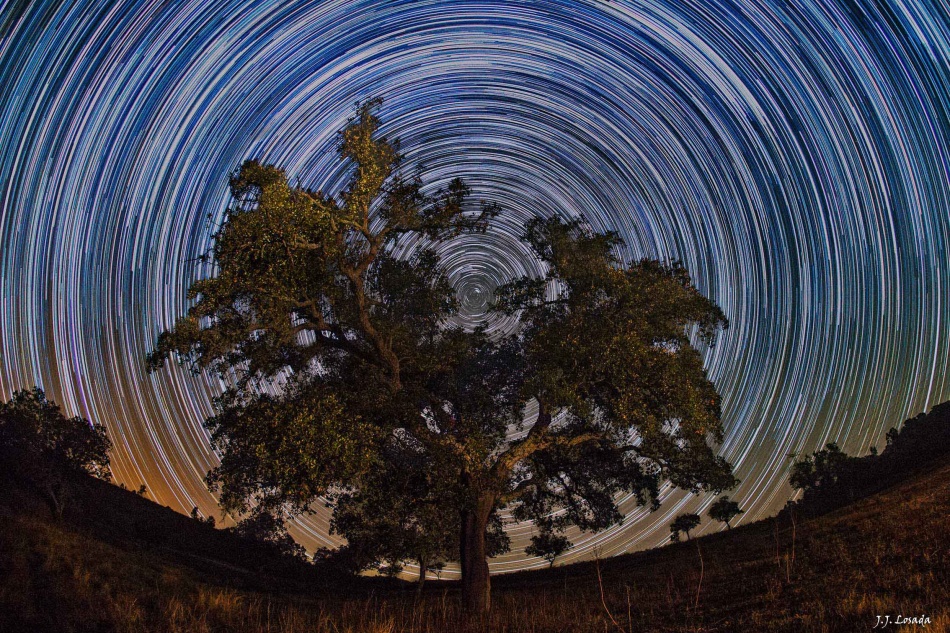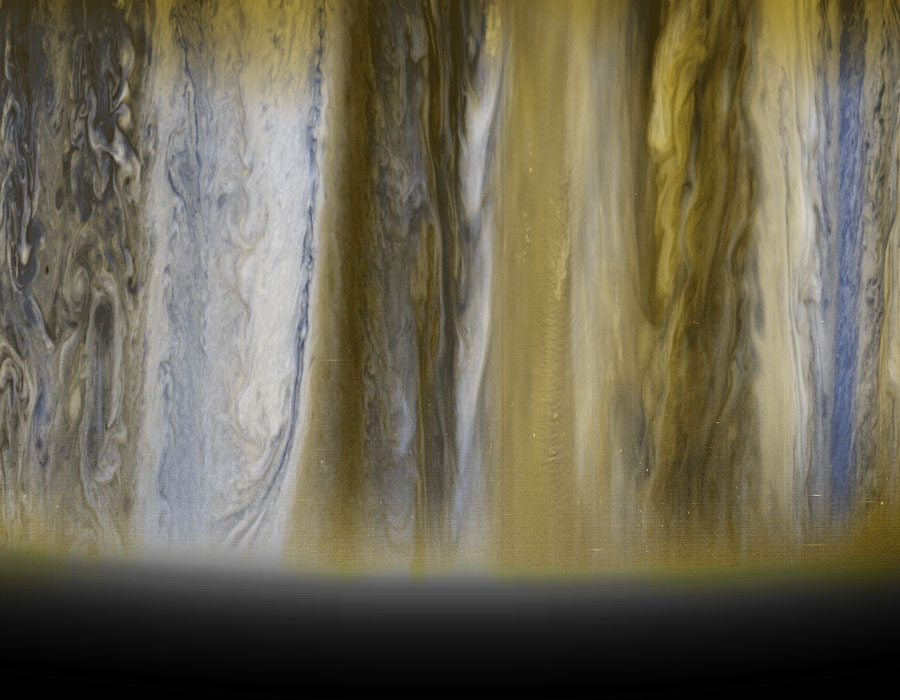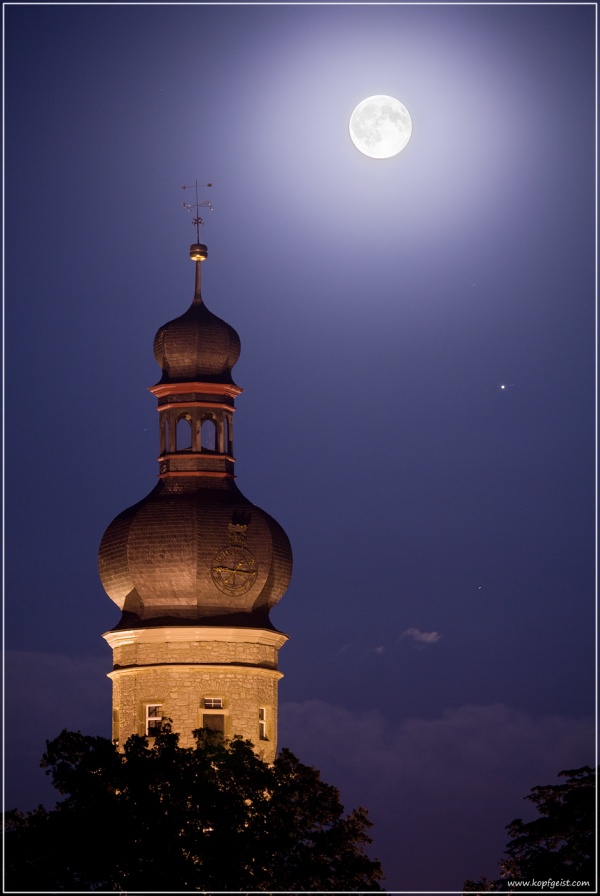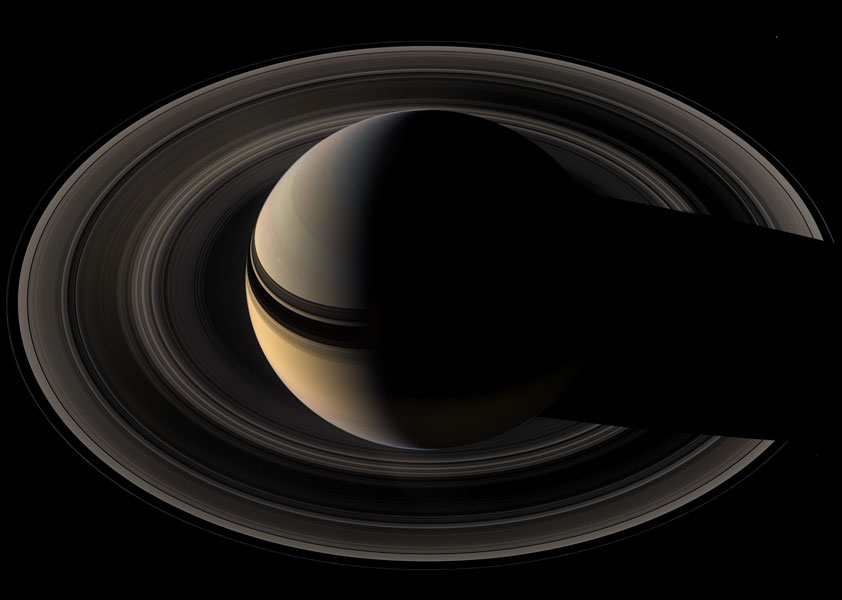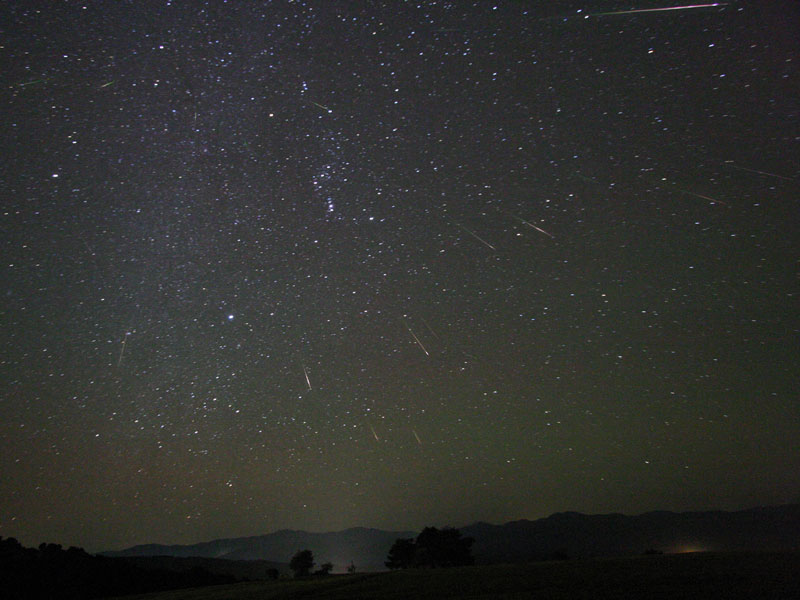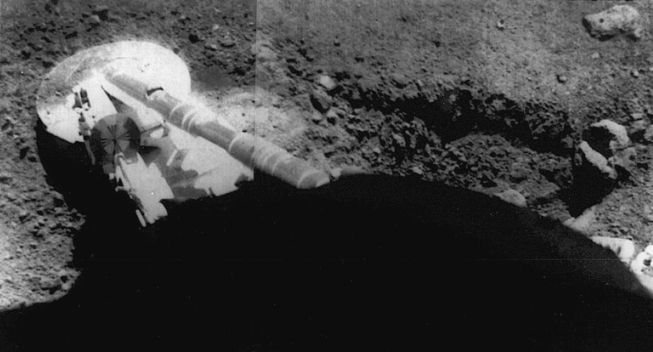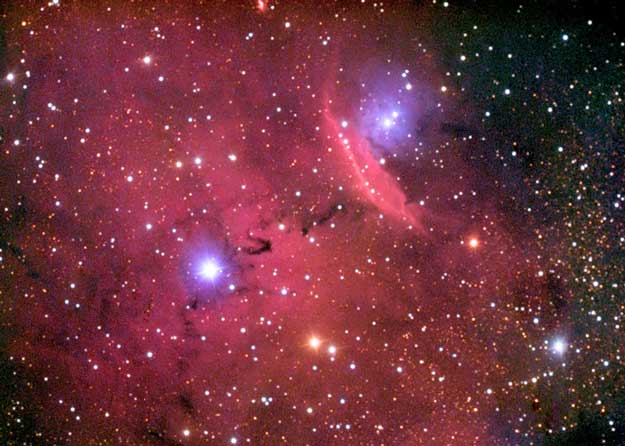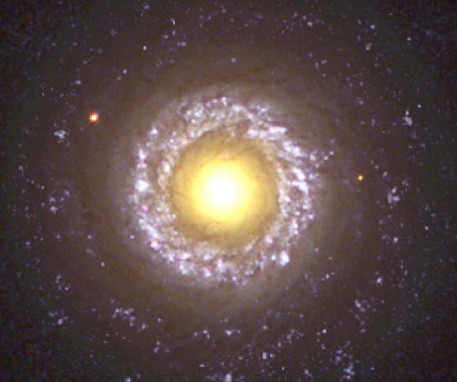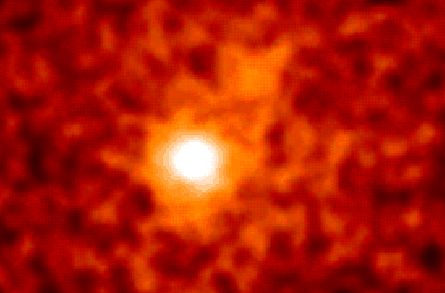| << Previous | Index | Next >> |
2014 This wide, sharp telescopic view reveals galaxies scattered beyond the stars and faint dust nebulae of the Milky Way at the northern boundary of the high-flying constellation Pegasus. Prominent at the upper right is NGC 7331. A mere 50 million light-years away, the large spiral is one of the brighter galaxies not included in Charles Messier's famous 18th century catalog. The disturbed looking group of galaxies at the lower left is well-known as Stephan's Quintet. About 300 million light-years distant, the quintet dramatically illustrates a multiple galaxy collision, its powerful, ongoing interactions posed for a brief cosmic snapshot. On the sky, the quintet and NGC 7331 are separated by about half a degree.
2013 If you climbed this magnificent tree, it looks like you could reach out and touch the North Celestial Pole at the center of all the star trail arcs. The well-composed image was recorded over a period of nearly 2 hours as a series of 30 second long, consecutive exposures on the night of October 5. The exposures were made with a digital camera fixed to a tripod near Almaden de la Plata, province of Seville, in southern Spain, planet Earth. Of course, the graceful star trails reflect the Earth's daily rotation around its axis. By extension, the axis of rotation leads to the center of the concentric arcs in the night sky. Convenient for northern hemisphere night sky photographers and celestial navigators alike, the bright star Polaris is very close to the North Celestial Pole and so makes the short bright trail in the central gap between the leafy branches.
2012 Normal cloud bottoms are flat. This is because moist warm air that rises and cools will condense into water droplets at a specific temperature, which usually corresponds to a very specific height. As water droplets grow, an opaque cloud forms. Under some conditions, however, cloud pockets can develop that contain large droplets of water or ice that fall into clear air as they evaporate. Such pockets may occur in turbulent air near a thunderstorm. Resulting mammatus clouds can appear especially dramatic if sunlit from the side. These mammatus clouds were photographed over Regina, Saskatchewan, Canada during the past summer.
2011 The New Horizons spacecraft took some stunning images of Jupiter on its way out to Pluto. Famous for its Great Red Spot, Jupiter is also known for its regular, equatorial cloud bands, visible through even modest sized telescopes. The above image, horizontally compressed, was taken in 2007 near Jupiter's terminator and shows the Jovian giant's wide diversity of cloud patterns. On the far left are clouds closest to Jupiter's South Pole. Here turbulent whirlpools and swirls are seen in a dark region, dubbed a belt, that rings the planet. Even light colored regions, called zones, show tremendous structure, complete with complex wave patterns. The energy that drives these waves surely comes from below. New Horizons is the fastest space probe ever launched, has now passed the orbits of Saturn and Uranus and is on track to reach Pluto in 2015.
2010
[imghover6=http://apod.nasa.gov/apod/image/1010/Or ... eo600h.jpg]http://apod.nasa.gov/apod/image/1010/Or ... eo600h.jpg[/imghover6]Credit & Copyright: Rogelio Bernal Andreo
2009 Driving along on a summer evening, near the small town of Weikersheim in southern Germany, photographer Jens Hackmann had to stop. He couldn't resist pointing his camera and telephoto lens at this lovely conjunction of a Full Moon and planet Jupiter looming near the steeple of a local church. Of course, 400 years ago, Galileo couldn't resist pointing his newly constructed telescope at these celestial beacons either. When he did, he found craters and mountains on the not-so-smooth lunar surface and discovered the large moons of Jupiter now known as the Galilean Moons. Jupiter's Galilean moons are just visible in this photo as tiny pinpricks of light very near the bright planet. Want to see the Moon and Jupiter better than Galileo? Look for local 2009 International Year of Astronomy activities and events during these next few Galilean Nights (October 22-24).
2008
[imghover6=http://apod.nasa.gov/apod/image/0810/M4 ... r_c800.jpg]http://apod.nasa.gov/apod/image/0810/M4 ... labels.jpg[/imghover6]Credit & Copyright: Tony Hallas
2007 Saturn never shows a crescent phase -- from Earth. But when viewed from beyond, the majestic giant planet can show an unfamiliar diminutive sliver. This image of crescent Saturn in natural color was taken by the robotic Cassini spacecraft in May. The image captures Saturn's majestic rings from the side of the ring plane opposite the Sun -- the unilluminated side -- another vista not visible from Earth. Pictured are many of Saturn's photogenic wonders, including the subtle colors of cloud bands, the complex shadows of the rings on the planet, the shadow of the planet on the rings, and the moons Mimas (2 o'clock), Janus (4 o'clock), and Pandora (8 o'clock). As Saturn moves towards equinox in 2009, the ring shadows are becoming smaller and moving toward the equator. During equinox, the rings will be nearly invisible from Earth and project only an extremely thin shadow line onto the planet.
2006 Meteors have been flowing out from the constellation Orion. This was expected, as mid-October is the time of year for the Orionids Meteor Shower. Pictured above, over a dozen meteors were caught in successively added exposures over three hours taken this past weekend from a town near Bursa, Turkey. The above image shows brilliant multiple meteor streaks that can all be connected to a single point in the sky just above the belt of Orion, called the radiant. The Orionids meteors started as sand sized bits expelled from Comet Halley during one of its trips to the inner Solar System. Comet Halley is actually responsible for two known meteor showers, the other known as the Eta Aquarids and visible every May. Next month, the Leonids Meteor Shower from Comet Tempel-Tuttle might show an even more impressive shower from some locations.
2005 At the center of our Milky Way Galaxy lies a black hole with over 2 million times the mass of the Sun. Once a controversial claim, this astounding conclusion is now virtually inescapable and based on observations of stars orbiting very near the galactic center. Using one of the Paranal Observatory's very large telescopes and a sophisticated infrared camera, astronomers patiently followed the orbit of a particular star, designated S2, as it came within about 17 light-hours of the center of the Milky Way (about 3 times the radius of Pluto's orbit). Their results convincingly show that S2 is moving under the influence of the enormous gravity of an unseen object that must be extremely compact -- a supermassive black hole. This deep near-infrared image shows the crowded inner 2 light-years of the Milky Way with the exact position of the galactic center indicated by arrows. The ability to track stars so close to the galactic center can accurately measure the black hole's mass and perhaps even provide an unprecedented test of Einstein's theory of gravity as astronomers watch a star orbit a supermassive black hole.
2004 "Safe!" In September 1967, during regular season play, the Surveyor 5 lander actually slid several feet while making a successful soft landing on the Moon's Mare Tranquillitatis. Equipped with television cameras and soil sampling experiments, the US Surveyor spacecraft were intended to determine if the lunar surface at chosen locations was safe for the planned Apollo landings. Surveyor 5 touched down on the inside edge of a small crater inclined at about 20 degrees. Its footpad slipped and dug the trench visible in the picture. Covered with dusty lunar soil, the footpad is about half a meter in diameter.
2003
[imghover6=http://apod.nasa.gov/apod/image/0310/cy ... del_c3.jpg]http://apod.nasa.gov/apod/image/0310/cy ... eledc3.jpg[/imghover6]Credit & Copyright: Steve Mandel, Galaxy Images
2002
2001 Bright gas and dark dust permeate the space between stars in a nebula known as NGC 6559. The gas, primarily hydrogen, is responsible for the diffuse red glow of the emission nebula. As energetic light from neighboring stars ionizes interstellar hydrogen, protons and electrons recombine to emit light of very specific colors, including the red hue observed. Small dust particles reflect blue starlight efficiently and so creates the blue reflection nebulosity seen near two of the bright stars. Dust also absorbs visible light, causing the dark clouds and filaments visible. NGC 6559 lies about 5000 light-years away toward the constellation of Sagittarius.
2000 Our Milky Way Galaxy is not alone. It is part of a gathering of about 25 galaxies known as the Local Group. Members include the Great Andromeda Galaxy (M31), M32, M33, the Large Magellanic Cloud, the Small Magellanic Cloud, Dwingeloo 1, several small irregular galaxies, and many dwarf elliptical and dwarf spheroidal galaxies. Pictured on the lower left is one of the many dwarf ellipticals: NGC 205. Like M32, NGC 205 is a companion to the large M31, and can sometimes be seen to the south of M31's center in photographs. The above image shows NGC 205 to be unusual for an elliptical galaxy in that it contains at least two dust clouds (at 1 and 4 o'clock - they are visible but hard to spot) and signs of recent star formation. This galaxy is sometimes known as M110, although it was actually not part of Messier's original catalog.
1999 While searching the skies above 18th century France for comets, astronomer Charles Messier diligently recorded this object as number 27 on his list of things which are definitely not comets. So what is it? Well, 20th century astronomers would classify it as a Planetary Nebula ... but it's not a planet either, even though it may appear round and planet-like in a small telescope. Messier 27 (M27) is now known to be an excellent example of a gaseous emission nebula created as a sun-like star runs out of nuclear fuel in its core. The nebula forms as the star's outer layers are expelled into space, with a visible glow generated by atoms excited by the dying star's intense but invisible ultraviolet light. Known by the popular name of the "Dumbbell Nebula", the beautifully symmetric interstellar gas cloud is about 1,200 light-years away in the constellation Vulpecula. This gorgeous synthetic color picture of M27 was produced during testing of one of the European Southern Observatory's Very Large Telescopes.
1998 This might resemble a fried egg you've had for breakfast, but it's actually much larger. In fact, ringed by blue-tinted star forming regions and faintly visible spiral arms, the yolk-yellow center of this face-on spiral galaxy, NGC 7742, is about 3,000 light-years across. About 72 million light-years away in the constellation Pegasus, NGC 7742 is known to be a Seyfert galaxy - a type of active spiral galaxy with a center or nucleus which is very bright at visible wavelengths. Across the spectrum, the tremendous brightness of Seyferts can change over periods of just days to months and galaxies like NGC 7742 are suspected of harboring massive black holes at their cores. This beautiful color picture is courtesy of the newly inaugurated Hubble Space Telescope Heritage Project.
1997
1996
1995 Gamma rays are more than 10,000 times more energetic than visible light. If you could "see" gamma rays, the night sky would seem very different indeed. The bright object in the center of the false color gamma-ray image above is quasar 3C279, a nondescript, faint, starlike object in the visible sky. Yet, in June of 1991 a gamma-ray telescope onboard NASA's orbiting Compton Gamma Ray Observatory unexpectedly discovered that it was one of the brightest objects in the gamma-ray sky. Shortly after this image was recorded the quasar faded from view at gamma-ray energies. Astronomers are still trying to understand what causes these enigmatic objects to flare so violently. Another quasar, 3C273, is faintly visible above and to the right of center.
| << Previous | Index | Next >> |
